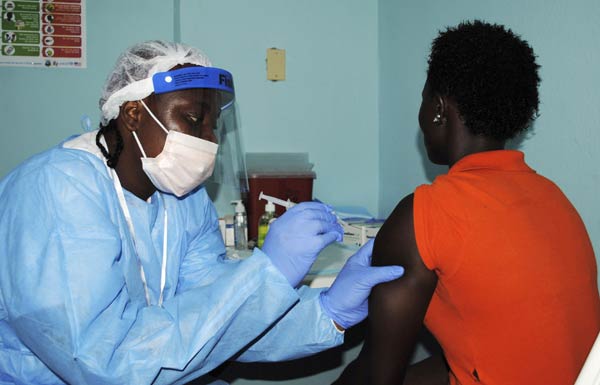Be ready to fight potential risks from P4 lab
By Shan Juan (China Daily) Updated: 2015-02-06 07:56
 |
|
A health worker injects a woman with an Ebola vaccine during a trial in Monrovia, February 2, 2015. [Photo/Agencies] |
The opening of China's first laboratory for level-4 pathogens (or P4) in Wuhan, Central China's Hubei province, recently is seen as a great achievement for the country. P4 refers to microbiology laboratory safety procedures to handle level-4 pathogens, that is, the most virulent viruses that have a high risk of person-to-person infection, of which Ebola is one.
Bio-security has for long been a worldwide concern. For instance, two lab researchers working on the SARS virus at the Center for Disease Control and Prevention in Beijing were infected by the deadly virus after it was accidentally leaked because of some employees' negligence in 2004. The infections spread to a few more people before being arrested, and five top officials of the center, including then director Li Liming, resigned after being held accountable for the "accident".
Worse, in 2011, two scientists - Yoshihiro Kawaoka of the University of Wisconsin-Madison and Ron Fouchier of Erasmus University in the Netherlands - succeeded in tweaking the already dangerous H5N1 bird flu virus in the lab into a more easily transmittable pathogen among humans. That created an uproar in the global science community and raised public fear that terrorists could use the example to create a lethal biological weapon.
Bio-terrorism is not an unfounded threat. Several anthrax attacks were reported in the United States in 2001. Letters laced with infectious anthrax were deliberately sent to media offices and US Congress and caused the deaths of five people.
Science and technology are a double-edged sword; they can save as well as kill people. And like any other country China is also vulnerable to bio-terrorist attack. It is this threat that the newly opened P4 laboratory in Wuhan will help fight.

I’ve lived in China for quite a considerable time including my graduate school years, travelled and worked in a few cities and still choose my destination taking into consideration the density of smog or PM2.5 particulate matter in the region.











